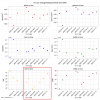jeffrey.kissel@LIGO.ORG - posted 12:05, Friday 25 August 2023 - last comment - 13:14, Friday 25 August 2023(72416)
Why is DELTAL_EXTERNAL BNS Range Reporting So Much Higher Than GDS-CALIB_STRAIN BNS Range? Test Mass Actuation Strength Has Drifted by 8% And CAL-DELTAL Doesn't Compensate For It; GDS-STRAIN Does.
J. Betzwieser, L. Dartez, J. Kissel Ryan Short recently updated the control room FOM for the BNS range (LHO:72415) which now shows -- with a clear legend -- the range computed using CAL-DELTAL_EXTERNAL_DQ vs. GDS-CALIB_STRAIN_CLEAN for both H1 and L1 observatories -- see example attached. This makes it dreadfully obvious that "L1's DELTAL_EXTERNAL range is right on top of the CALIB_STRAIN range -- but H1's is not, and DELTAL_EXTERNAL is *higher*." -- see First Attachment from the control room FOM screenshots. The natural questions to ask then are "why?" "is something wrong with H1's calibration?" No, there's nothing wrong.*** The discrepancy between DELTAL_EXTERNAL and CALIB-STRAIN at H1 is because the static test-mass stage actuation strength hasn't been updated since 2023-05-04 -- before the observing run started -- and it has slowly drifted due to test mass ESD charge accumulation -- and it's now at 8% larger than the May 04 2023 value. See the current value for the past 24 hours and a trend of the whole run thus far. L1's ESD strength has *not* drifted as much (see similar L1 trend), and they also regularly "fudge" their DELTAL_EXTERNAL actuator strength gains in order to get DELTAL_EXTERNAL more accurate (and they do so in a way that doesn't impact GDS-CALIB_STRAIN). H1 has chosen not to, to date. This drift is tracked and accounted for in our "time dependent correction factor" or TDCF system for that test-mass stage actuation strength, \kappa_T -- and GDS-CALIB_STRAIN (and STRAIN_NOLINES, and STRAIN_CLEANED) all have this correction in place. Check out the Second attachment from the same day's "CAL" > "h(t) generation" summary page, and walk with me: This plot is showing the ASD ratio (and thus roughly analogous to the magnitude of the transfer function) between all of the various stages of the calibration pipeline. - GDS-CALIB_STRAIN, GDS-CALIB_STRAIN_NOLINES, and GDS-CALIB_STRAIN_CLEANED are all this same from this perspective. Thus the ratio between these three channels with DELTAL_EXTERNAL in the denominator is highlighting the DELTAL_EXTERNAL is a preliminary product, and NOT corrected for TDCFs and thus there's a huge ~16% systematic difference between the two "stages" of product. - Recall that *all* of the four paths of the calibraion -- UIM, PUM, TST, and Sensing -- are being summed, and the cross-over frequency for these sums are all culminating around 50-200 Hz -- and in that region there's a factors of 2x to 3x gain peaking (see e.g. Figure 4 of P1900245) -- and thus the 8% drift in the TST stage strength means 16% systematic error in the DELTAL_EXTERNAL calibration. - However, the front-end version of the preliminary product that is corrected for TDCFs is also shown in the plot -- CFTD-DELTAL_EXTERNAL. The ASD ratio between this channel has MUCH less systematic discrepancy -- indicating that correcting for time-dependence (get it? CFTD!) does a LOT of the heavy lifting of accounting for this 8% TST drift. Of course, these ratios of different portions of the calibration pipeline don't *really* tell you if you've *really* done the right thing in an absolute sense. They only tell you what changes from step to step. (And indeed, the CFTD-DELTAL_EXTERNAL to GDS-CALIB_CLEANED ratio still shows *some* discrepancy.) The fact that fifth attachment, from the archive showing the constant *direct measurement* of the systematic error in the calibration -- from the absolute reference, the PCALs -- is nice and low (i.e. the transfer function is close to unity magnitude and zero phase) indicates that all of the correction for time-dependence is doing the right thing. *** Yet. In O3, L1 suffered a lot from TST strength drift. Joe has shown repeatedly that if you let an actuator TDCF drift too far beyond 10%, then the approximation we use to calculate these TDCFs breaks down (and see Aaron's work discussing it as a motivation for P2100107). In addition, since the real ESD strength is changing -- :: -- which is corroborated by the in-lock charge measurements -- I think -- see highlighted red region of sixth attachment from LHO:72310 -- :: -- that means the DARM open loop gain TF gain is also changing. This may impact the DARM loop stability (see e.g. LLO aLOGs 50900 and 50639). So, *eventually* we should resurrect the two things we've done in O3: (1) Reset the model of the static actuation strength for the TST stage to a more current value. (And thus start a new calibration epoch) (2) Potentially change the actual DARM loop by adjusting the DRIVEALIGN_L2L gain (3) Work up a solution to mitigate the drift -- perhaps doing something similar to what was done in O3, and play gains with turning on the ESD Bias voltage with the opposite sign when we're not in observing.
Images attached to this report
Comments related to this report
Louis has plotted DARM open loop gain transfer functions from May 2023 vs. Aug 2023 in LHO:72422. The comparison concludes we do NOT need to adjust the actual DARM loop (as suggested in item (2) above). In fact, the DARM OLG TF from August is *more* stable than it was in May (but not by much). This is indicative of a good robust loop design -- that ~10% level drifts don't impact the stability of the loop. We discussed further actions (1) and (3) based on the OLG TF results, and conclude the actions can wait until next week. But... probably not 2 weeks, again because the drift is close enough to the TDCF calculation's approximation breakdown point that we need to take action and "reset" the TST stage actuation strength.






